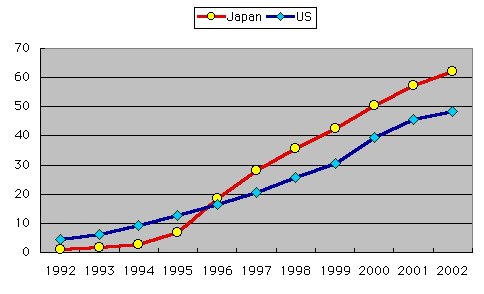US Wireless and Mobile Computing Market 2003
Cat: ICT
Pub: 2003
#: 0310a
George R. Hoffman
03930u/18216r
US Wireless and Mobile Computing Market 2003
|
Cat: ICT |
|
George R. Hoffman |
03930u/18216r |
Title
US Wireless and Mobile Computing Market 2003
米国ワイアレス・モバイル・コンピュ-ティング市場 2003
Index
Why?
- This is a summary report at IECP of Glocom, International University
of Japan, presented by George R. Hoffman, Managing Director, Yankee
Group Research Japan KK.
- 2000年9月、ジョージR.ホフマン、ヤンキーグループ日本支社長による国際大学GLOCOMでのIECP研究会での講演報告骨子である。
Summary
要約
>Top 0. Introduction:
- On September 3, 2003, IECP research forum of Glocom, International
University of Japan was held on the subject of "US Wireless
and mobile computing and wireless telemetry market." The speaker
was Mr. George R. Hoffman, managing director of Yankee Group Research
Japan.
- US wireless and mobile market aims to focuses on business sphere,
while Japanese one is supported by young consumers.
0.序文:
- 9月3日、ヤンキーグループのジョージ・ホフマン日本支社長を迎えて『米国におけるワイアレス・モバイル・コンピューティングおよびワイアレステレメトリー市場動向』
のテーマで国際大学GlocomのIECP研究会が行われた。
- 日本のモバイル市場が若年層のコンシューマによって支えられているのに対し、米国ではビジネス分野でモバイル市場の活性化を図ろうとしている。
>Top
1. US Wireless & Mobile Computing market:
- Active investment in mobile systems:
A research data indicates that more than half of enterprises are
planning to invest in mobile and wirelsss sector now or within 1-2
years. Though the overall investment is curtailed in recent trend,
the investment to wireless and mobile field is conspicuous.
- Market in business people:
There are about 12 million business people in US. It is forecast
that business people who use mobile devices like phone, PDA, etc.
grows from $130 million in 2002 to $1 billion in 2006.
- It is now used as point solutions; i.e., individual systems
with limited functions. It is critical to develop mission critical
systems Integrating mobile functions.
- Solution providers:
Many emerging ventures of wireless computing have withdrawn because
of depression of investment during 2001 - 2002 in US IT market.
Now major SIers such as IBM, Accenture, HP, CGEY, Siemens, EDS are
leading wireless computing solution market
- But, wireless technology has not yet grown as the primary
solutions for enterprises. And US carriers have not yet been
recognized as major providers of wireless solutions and processional
services.
1. 米国ワイアレス・モバイル・コンピューティング市場
- モバイル関連への積極投資傾向:
2003年の米国大手企業は、モバイル&ワイアレス関連投資について現在導入中および1-2年以内に導入すると回答した企業は半数を超えるとの調査結果に見られるように、ITへの投資が全般的に抑制傾向にある中で、ワイアレス関連へは積極的な投資姿勢を示している。
- 営業マンへの市場:
米国には約1200万人の営業マンがいるが、携帯電話やPDAなどモバイル・デバイスを利用するモバイル・セールスワーカーの市場規模は2002年の1.3億ドルから2006年には10億ドル以上に急増すると予測されている。
- 但し、現在はポイント・ソリューションという限定的な機能の個別システムで利用されており、今後はモバイル機能を統合した基幹システムに発展するか否かが課題である。
- ソリューション提供者:
米国では、2001-02年のIT分野での実質的な投資凍結を受けて新興のワイアレス・コンピューティング企業が次々と撤退する中で、現在はIBM、Accenture、HP、CGEY、Siemens、EDSなど大手SI企業がワイアレス・コンピューティング・ソリューションをリードしている。
- 但し、ワイアレス技術はまだ企業ITの主流にはなっていない。また米国のキャリアは、ワイアレス分野ではシステム統合やプロフェッショナルサービスを行えていない。
>Top 2. US Wireless Telemetry market:
- Business model of Wireless solutions:
As technologies of wireless communication, M2M (Machine-to-Machine)
communications, in particular, is getting promising according to
shift to 3G (CDMA-1X, GPRS) technology, meanwhile GSM remains still
useful. Business model does not seem promising at the moment due
to relative expansiveness of service fee and terminal cost.
- ROI:
To boost telemetry market, new differentiating applications and
high value added services are essential factors to make enterprise
users to feel confident in this system, being convinced of assured
ROI.
- M2M application:
Existing M2M applications are used in telemetry of public utility,
headway operation in fixed environment. The next application will
be used mobile environment which require high speed data communications
such as vending machine, asset & facility management, and security
systems.
- Telemetry services:
Major wireless operators in US consider telemetry services as new
source of revenue, focussing expansion of services of telemetry,
headway operation management, financial services, etc.
2.米国ワイアレス・テレメトリー市場:
- ワイアレスのビジネスモデル:
ワイアレス通信、特に、M2M (Machine-to-Machine) 通信は、3G(CDMA-1X、GPRS)への移行が有望視されるものの、GSMもまだ健在であり、またサービス料金、端末が高価でビジネスモデルが成り立っていない。
- ROI:
テレメトリー市場促進には、ユビキタス・ネットワークのインフラ整備と並んで、新たな差別的なアプリケーション、高価値サービスによって導入企業に投資効果(ROI)を確信させる必要がある。
- M2Mアプリケーション:
従来のM2Mアプリケーションは、公共料金検針、運行管理など固定環境で限定的に行われてきたが、今後は自販機、資産・機器管理、セキュリティなど移動環境で高速データ通信が可能なサービスが新規用途として登場してくる。
- テレメトリーサービス:
米国の主要ワイアレス事業者は、テレメトリーサービス市場を新たな収益源として見直し、検針、運行管理、金融サービスなどサービスの拡大に注力している。
>Top 3. RFID:
- RFID (Radio Frequency Identification):
RFID medium will be quite effective in a real world; when used
as remote controllers to control huge volume of commodities.
- RFID and WLAN comparison:
Both media have common features; both can provide location, identyty,
be intractive, and be deployed as pre-standard stage.
- EPC (Electronic Product Code) - UPC (Universal product Code) Comparison:
- EPC uses radio (no light of sight)
- EPC holds more data over 14-digit UPC.
- RFIUD can be re-programmed
- RFID more durable.
- Pilot experiment:
RFID is used to control supply chain.
- Wallmart: reduce theft, restock shelves, etc.
- Gillett: data accuracy, lost shipments
- Prada: try-on room
- Three conditions for diffusion of RFID:
- Further standardization: MIT's Auto-ID Center
- Price down of device price around $0.50/tag, targeting finally
around $0.01/tag.
- Price down of POS terminals
- Differential and visible value-added application by using
RFID.
3.RFID (ICタグ):
- RFID (Radio Frequency Identification):
RFIDは、大量の商品を管理するというリアル・ワールドでのリモートコントローラーとして効果的である。
- RFIDと無線LANとの比較:
位置特定ができ、個別認識でき、双方向であり、標準化以前から試行されている点など両者の共通点が多い。
- EPC(ICタグ) - UPC(バーコード)の比較:
- EPCは電波を使用(視野方向不要)
- EPCは14ビットのUPCより大容量
- EPCは再プログラム可能
- EPCはより耐久性あり
- 実証実験:
米国の小売業の分野ではサイプライチェインに活用
- Wallmart:盗難防止、在庫補充
- Gillet:データ管理、品切れ対応
- Prada:試着室用
- 課題:
今後のRFIDの普及には3つの分野での環境が整う必要がある。
- RFIDの標準化の進展:MIT Auto-ID Center
- デバイス価格の低廉化:(現在は$0.50/tag程度で、目標は$0.01/tag) もさらに廉価になること、
- POS端末側の機器も廉価になること、そして
- RFIDによる機能と付加価値の明確なアプリケーションの開発
>Top 4. <Reference> RFID data:
 Re:
Hitachi unveiled new RFID:
Re:
Hitachi unveiled new RFID:
(Source: http://www.rfidjournal.com/article/
articleview/556/1/1/)
Sept. 4, 2003, Hitachi unveiled a prototype of tiny RFID
mu-chip (0.4mm x 0.4mm), which features an antenna built onto the
microchip. It hold 128-bit serial number and can be embedded in
paper and used to authenticate bank notes, and other identification
documents, such as passport. It can prevent counterfeiting. The
currently cost of the new chip is $0.43 - 0.60/each). It can be
read from just 1 mm. The company has plans to embed the new mu-chip
in entrance tickets for Expo 2005 Aichi Japan, which opens on Mar.
25, 2005.
- Features of RFID tag:
- System:
The system is made up of a microchip with a coiled antenna, and
an interrogator or reader with an antenna. The reader send out electromagnetic
waves that form a magnetic field when they couple with the antenna
on the RFID tag.
- Cost:
- RFID readers typically cost $1,000 or more.
- RFID chips cost as little as $0.30, as much as $50 per tag.
- Power:
- Passive tag has no battery, and draw power from the magnetic
field.
- Active tag has a battery and can cost far more.
- Semi-passive tag use a battery to run the chip's circuitry,
but communicate by drawing power from the reader.
- "Energy harvesting" is a technique in which energy
form the reader is gathered by the tag, which stores momentarily
and transmits back at a different frequency. This method may
improve the performance of passive tags
- Frequency:
Low-frequency tags are cheaper than UHF tags, use less power and
are better able to penetrate nonmetallic substances (like water).
- Low: around 125 KHz
- High: 13.56 MHz
- UHF: 850-900 MHz (915 MHz in US, while 868 MHz in Europe)
- Microwave: 2.45 GHz
- Shield:
- Radio waves bounce off metal and are absorbed by water at
higher frequencies.
- Read range:
- Passive tag: less than 10 feet.
- Active tag: 100 feet or more.
- Information stored:
- no more than 2KB
- Variation:
- Read-only tag;
- Read-write tag; more expensive, but useful in some specialized
applications.
- RFID with sensor; may alert if not stored at the right temperature.
- Intelligent software embedded: automate routine decisions, otherwise
human are overwhelmed by the amount of data
- Signal collision:
- Reader collision: one reader can interfere with the signal
from another where coverage overlaps.
- Tag collision: more than one chip reflects back a signal at
the same time, confusing the reader. Since they can be read in
milliseconds. (TDMA)
- Standards:
- GTag (ISO 18000-6); is promoted by EAN and UCC as a way to communicate
with UHF tags.
- Auto-ID; Auto-ID Center is the de facto standard
- Common applications:
Applications are limited only by people's imagination.
- Tracking cows and pets, triggering equipment down oil well.
- Tracking goods in supply chain, tracking assets, tracking
parts
- Security: controlling access
- Payment system
- Battlefield intelligence: sensors
4.<参考> RFIDデータ:
- ニュース:日立、RFID新製品発表:
2003年9月4日、日立は小型RFIDμチップ(0.4mm角) の試作品を発表。これはアンテナをチップ内に搭載している。また128ビットの連番付で、紙や証券やパスポートなど証明を要する文書の認証用に埋め込み可能で、偽造を防げる。このチップの現状の価格は1個当たり43-60米セント。1mmから読み取り可能。日田市はこの新たなμチップを2005年3月25から開催される愛知万博の入場券に埋め込む計画がある。
- RFIDタグの特徴:
- システム:
このシステムは環状アンテナ内蔵マイクロチップとアンテナ付のリーダとで構成される。リーダは電磁波を出すことで磁界を作り、RFIDタグのアンテナと接続する。
- コスト:
- RFIDリーダ:$1,000以上
- RFIDチップ:最低30セント、最高で$50程度
- 電力:
- パッシブ・タグは電池なし。磁界から電力を得る。
- アクティブ・タブは電池内蔵で、製造コストは高い。
- セミ・パッシブタグは電池をチップの回路用には使用するが、通信用にはリーダから電力を得る。
- 「エネルギー・ハーベスティング」
- 周波数:
低周波のタグはUHFタグより廉価で、省電力で、水のような非金属物質をより良く透過する。
- 低周波:125 KHz
- 高周波:12.56 MHz
- UHF:850-900 MHz (米国では915 MHz, 欧州では868 MHz)
- マイクロ波:2.45 GHz
- 遮蔽:
- 電波は金属で反射し、高周波数では水で吸収される。
- 読み取り距離:
- パッシブタグ:3m以内
- アクティブタグ:30m以上
- データ貯蔵量:
- 2KB以下
- 種類:
- リードオンリー・タグ
- リード/ライト・タグ、より高価だが特定アプリケーションでは有効
- センサー付RFID:適温に貯蔵されない場合警告
- インテリジェント・ソフトウェア埋め込み:ルーティン決定の自動化、さもないと大量データによって人間が忙殺される。
- 信号衝突:
- リーダー衝突:あるリーダは他のリーダと重なる領域での信号と干渉し得る。
- タグ衝突:
多くのチップが動じに信号を返すことでリーダが混乱する。リーダは時分割多元接続(TDMA)をすることになるが。
- 標準化:
- GTag (ISO 18000-6)はEANおよびUCCがUHFタグとの通信方法として標準化推進中。
- 応用分野:
アプリケーションの応用は人々の想像力次第。
- 牛やペットの追跡、石油井戸掘削器具の管理
- サプライチェインでの物流管理、資産管理、部品管理
- セキュリティ:アクセス管理
- 支払システム
- 戦場でのインテリジェンス・センサー
>Top
5. <Reference> US Mobiles carriers:
- US Mobile carriers: (as of
4Q/2002)
Carrier
Communication Method
Sub-scribers
Share
Verizon Wireless
AMPS, CDMA, CDMA1900
32,491
23.3%
Cingular Wireless
AMPS, TDMA, GSM1900
21,925
15.7%
AT&T Wireless
AMPS, TDMA,TDMA1900, GSM1900
20,859
15.0%
Sprint PCS
CDMA1900
14,760
10.6%
Nextel
iDEN
10,610
7.6%
T-Mobile
GSM1900
9,916
7.1%
Alltel
AMPS
7,602
5.5%
US Cellular
AMPS, TDMA, CDMA
4,103
2.9%
Western Wireless
AMPS, TDMA
1,198
0.9%
US West
CDMA1900
1,034
0.7%
Others
14.720
10.6%
Total
139,217
5.<参考>米国モバイル通信会社:
- 米国モバイル事業者:(2002年4Q現在)
上位3社合計は過半数のシェア獲得
- 日米モバイル普及:(普及率%、1992-2002)
1996年に日本がモバイル普及率で米国を抜く
- Proliferation of Mobile Phone: (%: US vs. Japan):

Comment
- Nightmare of RFID:
If this extremely small device is used as unlimited personal surveillance
by Big Brother, which will be a nightmare. It is OK this chip is
used as commodity control. But if EPC-implants are used to trace
our behavior when and where we go and buy what kind of books, etc.
, and meet with whom, etc....then could we expect any rebel to throw
an hammer to escape from '1984' situation?
- This RFID should have a limit of usage and
lime to life, and also "RFIDcide" must be developed;
killing or disinfecting all functions thoroughly of this device.
- RFIDの悪夢:
もしこの微小なデバイスがビッグ・ブラザーによって無制限の個人監視に利用されたとしたら、それは悪夢である。このチップが商品管理に使用されるのはよい。しかし、この体内に埋め込まれたチップによって我々がいつどこへ行き、どんな種類の本などを購入し、誰と会ったのかなど追跡に使われるとしたら... 我々は1984年状態から逃れるために反逆者がハンマーを投げつけるのを期待できるだろうか?
- このRFIDには使用制限や寿命を設定すべきである。そしてこのRFID殺虫剤を開発して、このデバイスの機能を完全に殺して除菌しなければならない。
Title |
US Wireless and Mobile Computing Market 2003 |
米国ワイアレス・モバイル・コンピュ-ティング市場 2003 |
|---|---|---|
Index |
||
Why? |
|
|
Summary |
要約 |
||||||||||||||||||||||||||||||||||||||||||||||||||||
>Top 0. Introduction:
|
0.序文:
|
||||||||||||||||||||||||||||||||||||||||||||||||||||
>Top 1. US Wireless & Mobile Computing market:
|
1. 米国ワイアレス・モバイル・コンピューティング市場
|
||||||||||||||||||||||||||||||||||||||||||||||||||||
>Top 2. US Wireless Telemetry market:
|
2.米国ワイアレス・テレメトリー市場:
|
||||||||||||||||||||||||||||||||||||||||||||||||||||
>Top 3. RFID:
|
3.RFID (ICタグ):
|
||||||||||||||||||||||||||||||||||||||||||||||||||||
>Top 4. <Reference> RFID data:
|
4.<参考> RFIDデータ:
|
||||||||||||||||||||||||||||||||||||||||||||||||||||
>Top 5. <Reference> US Mobiles carriers:
|
5.<参考>米国モバイル通信会社:
 |
Comment |
|
|